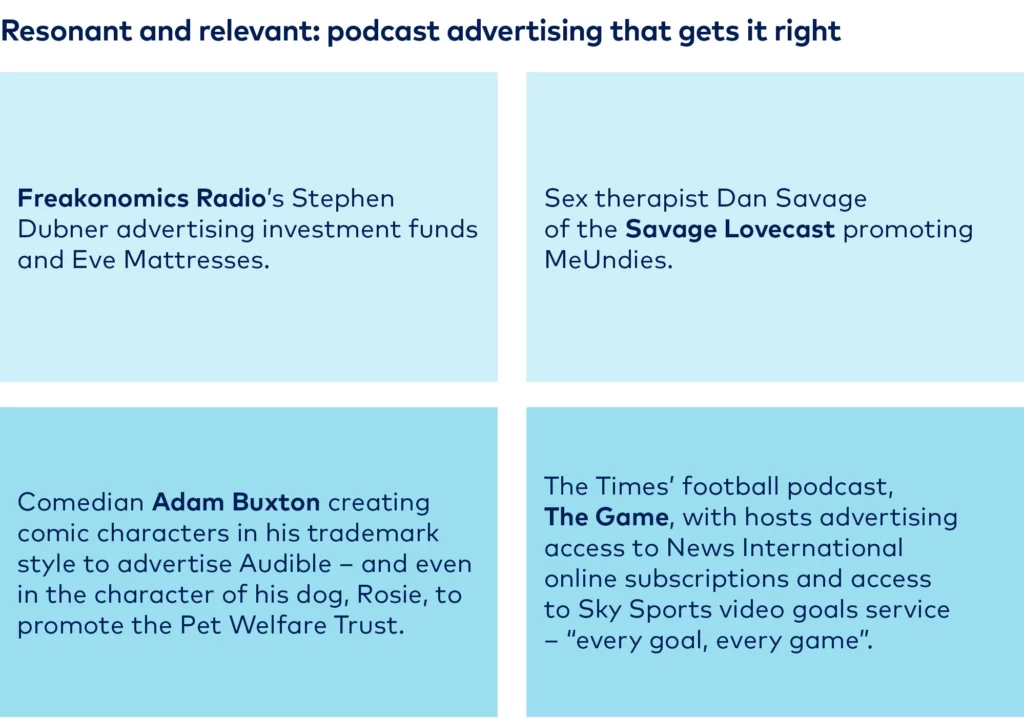There’s a quiet revolution happening in audio and that revolution is podcasting. In the U.S. alone it’s estimated that there are more than 750,000 different podcasts. Their collective back catalogue offers more than 30m episodes, available to download and stream on YouTube, Apple Podcasts, Spotify, and a host of other podcast apps. The meteoric growth in podcast listening – up 157% since 2014 – has been driven by saturation penetration of smartphones. The rise of the smart speaker is accelerating growth and reach still further, and connected cars are only likely to add to the growth in on-demand audio.
Ad spend in podcasting, not surprisingly, is growing too, though it’s still a relatively small advertising market. Podcast advertising is currently worth up to $800m globally, and WARC expects this to double by 2022. By then, podcast advertising will account for approaching five percent of all audio ad spend. According to digital audio advertising platform DAX, 75% of UK advertisers intend to increase podcast advertising spend during 2019.
Ads can be served in a number of different ways in podcasts. This includes dynamic serving at the point of downloading and/or listening, offering advertisers the most flexibility in terms of targeting. It includes ads served as an integral part of programming, stitched into the audio fabric of the podcast. And it includes ads voiced by the podcast host or hosts, which research shows has greatest resonance with listeners, who are often passionate and loyal fans of their chosen podcasts’ content.
The upsides
Engagement with podcast content, both editorial and advertising, is generally quite good. Listeners make an active choice to subscribe to, download, and listen to podcasts. It’s what they want to listen to, when and where they want it. This makes them more engaged when listening to podcasts than when they play broadcast radio, which is often just on in the background. A Nielsen study for podcast advertising company MidRoll showed that podcast ads are 4.4 times more effective than display ads. Exposure to ads in podcasts leads to an average 10% uplift in purchase intent; 61% of podcast listeners said they were likely to buy compared with 56% of listeners who did not hear an ad.

Successful podcast advertising is not just about taking radio ads and force-fitting them into podcasts, just as online video advertising is about more than taking TV commercials and jimmying them into YouTube or Facebook. Ads voiced – and styled – by podcasts host work particularly well. Podcast listeners have a close and intimate relationship with hosts. They trust them, and host-voiced ads feel much more relevant to listeners. Ads that are relevant to the podcast are also more effective – as with any medium. But as podcasts are often much more focused and niche than talk radio, there are opportunities for specific ads for specific products and demographics available through podcasting that radio cannot hope to emulate. Lastly, mid-roll placement is best, as listeners are more likely to skip pre-roll ads and they also tend to stop listening at the end of the podcast, before post-roll and credits.
The downsides
Despite the current positives and future potential of podcast advertising, the scale of the audience is still very small; targeted, of course, but small. The MidRoll study notwithstanding, measurement of effectiveness can be difficult. Indeed, data on how many podcasts are listened to all the way through once downloaded is sketchy at best. So brands investing in podcast advertising need to track brand awareness over time and tease out incremental effects of podcast investment. Equally, many advertisers use ads in podcasts to drive direct response with specific promotions that can be tracked through to point of sale.
What’s more, podcast apps – designed to deliver podcasts, not ensure that ads are played – allow listeners to skip ads with ease if they find the content boring or irrelevant. This can be mitigated by creating ads that are interesting and relevant and voiced by hosts. But a podcast listen – let alone a simple download – cannot guarantee that any ad has actually been heard. And because podcast advertising is in its relative infancy, excessive frequency can become an issue. Ads are typically sold for multiple episodes or series, so listeners can quickly tire of the same ad played across multiple episodes of the same show.
In summary
Podcast advertising is small and niche, but growing, targeted, personal, and impactful. Advertisers not currently investing in the medium should definitely consider it, but it is best thought of as a part of a wider digital audio buy rather than planned separately.



